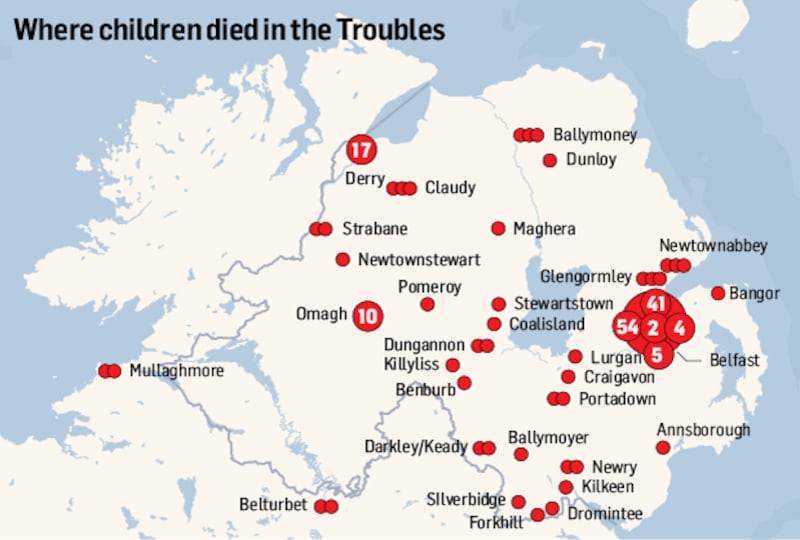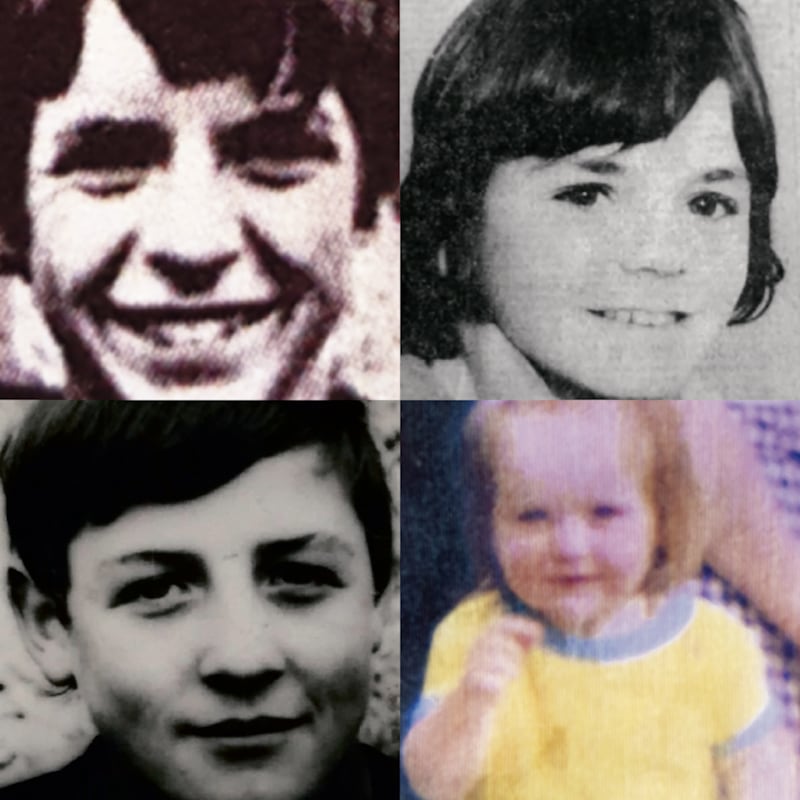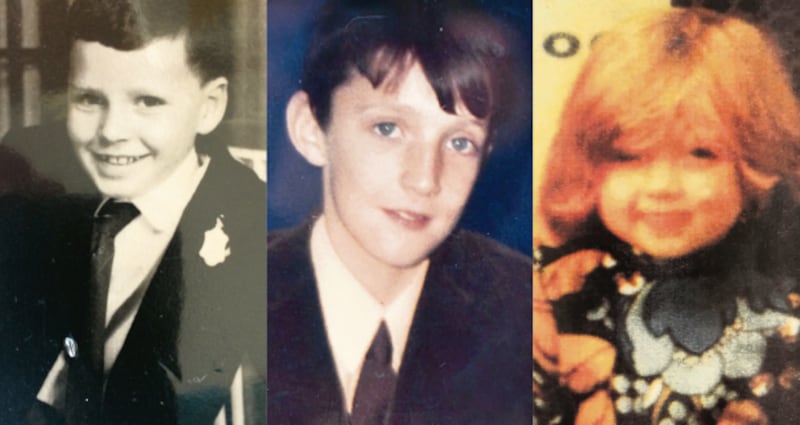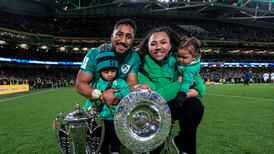Patrick Rooney loved horror movies and Halloween, and wanted to be a priest when he grew up. In August 1969, the nine-year-old was killed when the RUC fired into his home during rioting in Belfast, the first of at least 186 children to die in what would become known as the Troubles in Northern Ireland.
Their stories are told for the first time in a new book by the RTÉ broadcaster Joe Duffy and Irish Times Northern Correspondent Freya McClements. Children of the Troubles, which is published next week, is based on original interviews with almost 100 families and includes children who have never previously been publicly acknowledged as victims of the Troubles.
From the teenage striker who scored two goals in the schools’ cup final, to the boy who loved animals so much he “saved every little creature around him”, and the five-year-old who wrote in her copybook on the day she died, “I am a good girl, I talk to God”, these are their stories.
When 14-year-old Philip Rafferty left his home in west Belfast to go to band practice, his mother, Maureen, made sure he was wearing his new winter coat. The next time she saw it was in a plastic bag at his inquest, saturated with blood.
On January 30th, 1973, Philip was on his way home when he was abducted from the street by loyalist paramilitaries. He was taken to the Giant’s Ring, outside Belfast, where they hooded him with his coat, beat him, and then shot him several times.
The night before, the same UDA gang had shot and killed another teenager, Peter Watterson, who was standing outside his mother’s newsagents on the nearby Falls Road. Philip and Peter were among a number of victims of sectarian murders of Catholic children carried out by loyalists at that time.
“That night I told Philip to avoid the main roads because they were shooting out of cars, and he said, ‘Nothing’ll happen to me, Mum.’”
It took Maureen 25 years to speak about her son – an affectionate, generous boy who loved music, who played the violin and the flute, who wanted to be an architect and had promised to build his mother a bungalow.

He is one of at least 186 children, aged 16 and under, who lost their lives because of the North’s Troubles, yet his story remains largely unknown. “Nobody knows my Philip’s name,” says Maureen.
“They took a child off the road, put his hood over his head and murdered him. I think the world should know these things.”
Her words could stand for any of the families who spoke to us during the research for Children of the Troubles.
“There were so many,” says Maureen. “You were looking at the news every night and there was someone else and your family was just one of many, many, and you just thought, he didn’t count, he was only a child.
“It took me until his 25th anniversary and then I thought, I’m going to tell the world what happened to him.”
The Troubles brought war onto the streets where children like Philip and Peter lived. The circumstances of their deaths, and those of many others, are typical of childhood: 18-month-old Angela Gallagher was going to the shop for sweets; best friends Claire Hughes (4) and Paula Strong (6) were dressed in witches’ costumes for Halloween; 13-year-old Joseph McGuinness was getting chips.
The first child
Nine-year-old Patrick Rooney, the first child to die as a result of the Troubles, was killed inside his own home. “They can’t say to me he was in the wrong place at the wrong time,” his father Neely told the Irish News. “He was in his home when he was shot dead.”
Of the 186 children who would be killed between Patrick’s death in August 1969, and that of Michael McIlveen in May 2006, 18 of them – 10 per cent – were fatally injured in their own homes; many more were killed on the streets outside.
“It was like Syria, but without the [aerial] bombings,” says Margaret McGuigan. Her younger brother Francis was just a month away from his second birthday when he died in April 1970; his family believe it was from the effects of breathing in CS gas.
The McGuigan family lived in "the end house" in the Bullring in Ballymurphy, west Belfast. "We grew up with a lot of gunfire, with the army just coming in, the doors banging, the bin lids going, bombs up the street.
“My kids can’t get it into their heads that we played in the street and when the shooting started you ran into the house and then when the shooting stopped you came back out,” says Karen McAllister. Her younger sister, four-year-old Siobhan McCabe, was shot and killed in 1975 as they ran home from their granny’s house across the street.
“In the park, they’d be shooting through the railings so everybody would lie under the roundabout, and when it stopped you got back up and got back on again. Imagine that nowadays. We didn’t know anything else. It was just the way it was.”
Urban, economically deprived areas like the Lower Falls in west Belfast, where the McCabes lived, were disproportionately affected; so too were Catholic ones.
Of the children killed during the course of the Troubles, 80 per cent were Catholic. Twenty-nine per cent of deaths took place in west Belfast, and 24 per cent in north Belfast. Together they represent 95 fatalities, more than half of the children killed as a result of the Troubles. Two-thirds of children’s deaths took place in Belfast and Derry.

In Belfast, the names of areas such as Ardoyne, Ballymurphy and the Falls became part of the geography of the Troubles; in Derry it was Creggan and the Bogside.
Similarly, Protestant working-class districts such as the Shankill in west Belfast, or interface areas in north Belfast, were more sharply affected than middle-class parts of the city.
“If Brian [Stewart] had been born in the Malone Road he wouldn’t be dead,” points out his sister Marie Duffy. The 13-year-old from Turf Lodge died after he was shot with a plastic bullet in 1976. “If my mummy had married my uncle Billy instead of my da and we lived in Ballybeen he wouldn’t have been dead, because they weren’t running around shooting Protestant kids.”
Born in 1962, Brian would barely have remembered a time before the Troubles. The British army, the IRA, the fear of loyalists, the rioting, the petrol bombs, the plastic bullets would all have been commonplace, a new form of normality which had been quickly absorbed into the fabric of childhood.
‘It was great’
In his memoir of growing up in Derry, Tony Doherty – then six – describes how, in August 1969, the soldiers and their newly constructed “sangar” became the centre of attention in his street.
“We played football at the bottom of the street next to it, instead of up the street. Women, including me ma, brought them tea, buns and sandwiches in relays. . . the soldiers allowed us to look down the sights of the SLRs [guns], picking out people as targets.”
This quickly changed. “Within a year of me bringing the Brits – who were outside the front door with their sandbags – a Penguin and a cup of coffee from my mum, we were making paint bombs and chucking them at Saracens,” says Peter Watterson’s brother Johnny.
“The Troubles consumed everything,” says Jim Dougal. His 16-year-old brother John was shot dead by the British army in 1972. “I still don’t follow football teams, because that stage in life where a boy gets interested in things like that was gone. We might have played the odd game of handball but that was about it, in between rioting. It was all the Troubles, the rioting, the Brits.”

For a child, it could be exciting. "It was great," says Ted Healey. "You had all the freedom, throwing stones, which children loved to do, and when you got chased by the army your adrenalin was going. We didn't go to school – you were given a 'by ball' because of the Troubles, so for weeks on end you'd hear there was a riot down in such and such a place, Andersonstown, say, so you'd go down and join in."
Ted’s twin brother Dessie was shot and killed during a riot in Lenadoon on the afternoon of the introduction of internment in August 1971. Among Dessie’s friends was Martin Livingstone, whose younger sister Julie died after she was hit by a plastic bullet in 1981.
“Martin and his friend Mickey were there the day Dessie was shot,” says his sister Elizabeth Livingstone. “When it was Dessie’s 40th anniversary they got together and raised some funds to have a wee plaque put up, because nobody ever talked about Dessie.
“Every time we were talking about Julie, Martin would always talk about Dessie, and I think what we’ve discovered is the ripple effect their deaths had on their contemporaries, on the kids that went about with them.”
Mental scars
Children survived the deaths of mothers and fathers, brothers and sisters, best friends. They saw friends and relatives interned, or imprisoned. They were themselves “lifted”, beaten, jailed. Many were physically injured, and more again were left with mental scars.
Seamus Mallon, who later became Northern Ireland's deputy first minister, recalled teaching English at St Catherine's College, a girls' school in Armagh, during the 1970s. "I had one small class, and every one of those girls had somebody belonging to them killed."
John Lyttle’s father Tommy was the brigadier of the west Belfast brigade of the UDA. “Every day of my childhood, and I do mean every day, from the age of about nine until I left at 18, I expected to die,” he told Bill Rolston. “I thought about death every day. Getting on the bus, it’s going to blow up. Walking past Unity Flats, is a sniper going to take me out?
“In the house, I couldn’t sit with my back to the front window, because every time a car would pass, the blood would drain from me.”
In Belfast, the city’s sectarian fault lines had hardened in August 1969. The burning of Bombay Street in west Belfast and the attendant violence that summer was the beginning of a pattern by which previously “mixed” areas were redefined as either Catholic or Protestant, as families were either forced to leave or chose to move.
Prof Marianne Elliott, in her evocative memoir of the White City housing estate in north Belfast, Heartlands, describes this as a “sectarian reordering of space”; that year 3,570 families fled mixed areas in the west and northwest of Belfast, and yet more left in the weeks following the introduction of internment in 1971.

The Dougal family lived in Manor Street in north Belfast; they were one of a few Catholic families in the predominantly Protestant street. “We played with Protestants,” says Jim, “and we used to have bonfires and everything.”
On August 16th, 1969, they were told to get out. “It was the middle of the night, and I remember we were all brought downstairs and dressed. Me and John were looking out of the window, and we saw the people knocking on doors and I remember saying to John, look at those policemen, they’re not stopping those bad people.
“Eventually they knocked on our door and told us to get out and my da said, ‘I’ve seven children, where am I going to go at this time of night?’”
The next morning, the family piled into his uncle’s car. “That was the last we saw of Manor Street.”
A few days later, John and Jim sneaked back, climbing over the back wall; “Fenians out” had been scrawled above their fireplace.
Inevitably, children dressed in school uniforms became a familiar sight at funerals. Among them were the friends of 11-year-old Lesley Gordon from Maghera in south Derry. She was killed in 1978 along with her father Willie, a school welfare officer and part-time member of the UDR, as he was about to drive her and her brother to primary school. The IRA bomb had been hidden in a cavity in the car.
Checking for bombs
Children of security forces grew up used to parents always checking under their car. They knew, even from a young age, that they could not tell their friends what their father’s – or mother’s – job was.
“I always told the children I was looking for cats until one day my then 12-year-old son said, ‘You’re not looking for cats, are you? You’re looking for bombs,’” said Mark Lindsay, a former RUC officer who is now chairman of the Police Federation, in an interview with The Irish Times.
“Another young child asked, ‘If you are a fireman why are you always driving into police stations?’”

For most children, the Troubles were a backdrop to their lives, something overheard on the radio or observed by chance as their parents watched the television news; its physical manifestation came, most frequently, in army or police checkpoints, or in bomb scares.
Shoppers in Belfast had to pass through a so-called “ring of steel” to get into the city centre; bags – and even children – were searched. Families avoided the centre of Belfast because of the frequency of explosions; bomb scares were commonplace.
Youth clubs and discos, run by community centres or by local churches, aimed to keep children off the streets.
In May 1981 Roberta Guiney – whose son Desmond and husband Eric were killed after Eric's milk lorry was attacked by rioters in the New Lodge in North Belfast amid disturbances following the death of hunger striker Bobby Sands – pleaded with other mothers.
“Their mothers should not have let them out,” she told the Belfast Telegraph. “I would never have let any child of mine out on the streets doing something like that – the kids are just being used by the perpetrators of violence.”
Project Children, founded in 1975, took 23,000 young people, Catholic and Protestant, away to America for the summer and, quite literally, a better life. One of their success stories, Charles Love, had been twice to New York State and had planned to return to go to high school there; the day he was killed, he should have been in the States, not in Derry.
‘A wee taste’
In Northern Ireland, the majority of children are still educated in schools which are split along religious lines. Integrated schools, which deliberately bring together staff and pupils of both Protestant and Catholic faiths, as well as other religions and none, were attended by 7 per cent of students in 2014/2015, according to Department of Education figures.
Divisions are also physical. In Belfast in particular, so-called peace walls that continue to separate communities living along “interfaces” are testament to the continued division in Northern Ireland.
In the 50 years since the death of Patrick Rooney, the streets of Northern Ireland have changed. For the most part, they are now at peace; yet most would agree that much remains to be done. A 2019 report by Ulster University found that “latent sectarianism persists in Northern Ireland. . . we now have to ask if the capability exists to provide solutions to these problems or whether we must simply hope that with the passage of time they will somehow just go away.”

Maureen Rafferty is in her 80s; her other children now live in England. “I encouraged them to go away, because I knew they would be safe.”
When she goes into Belfast city centre to shop, she marvels at how well the city is doing. “Isn’t it wonderful? There are so many businesses coming on now, and there are so many nationalities of people – you hear the different accents, the different tongues.
“So many people come here now and they’re going on those Troubles tours, and it’s given them a wee taste of what went on here.”
She pauses, and looks towards Philip’s picture. “The world needs to know.”
Children of the Troubles, by Joe Duffy and Freya McClements, is published by Hachette Ireland on Thursday, October 10th


















